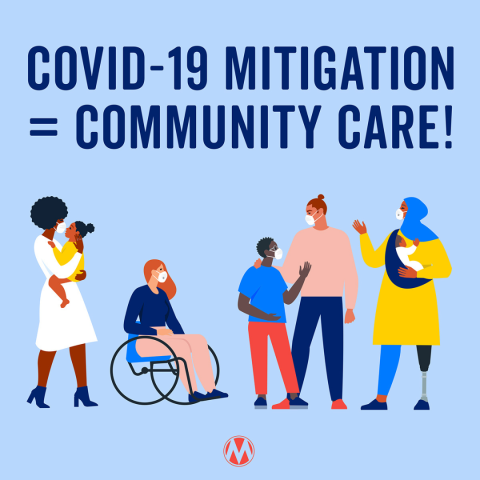
Let's Address the Virus in the Room... Everything You Need to Know About COVID-19
[This blog post was updated the week of August 5, 2024.]
As we approach the end of Disability Pride Month today, we want to give you a COVID-19 crash course on everything you need to know and more! The United States is currently seeing massive increases of COVID-19 cases, with one report estimating that as of August 2, 2024, approximately 1 out of 37 Americans are currently infected with COVID-19. COVID-19 and the damage that has resulted for millions of people after infection is a phenomenon long COVID patient and advocate Charlie McConne described as "'the greatest mass-disabling event in human history.'"
Once the first rollout of the COVID-19 vaccines began in 2021 and the Department of Health and Human Services officially ended its COVID-19 Public Health Emergency status on May 11, 2023, many people began to let their guard down and tried to wipe it out as a memory “during the pandemic”. However, COVID-19 is not “mild,” nor should it be taken lightly; it is an ongoing virus that can have long-lasting effects for millions of people. Although some higher-risk communities like the immunocompromised, those aged 50 years or older, and our babies and children—with approximately 5.8 million children developing long-term damage from their COVID-19 infections—have an increased chance of catching COVID-19, EVERYONE is at risk of getting COVID-19 but dealing with potential long-term damage.
COVID-19 101
COVID-19, which stands for coronavirus infectious disease-2019, is a disease caused by the virus severe acute respiratory syndrome coronavirus 2, or SARS-CoV-2. COVID-19 was the fourth leading cause of U.S. death for all ages in 2022 and the eighth leading cause of death in U.S. children and adolescents between 2021 to 2022.
COVID-19 is airborne, often lingering and moving through the air like smoke. Some reports say SARS-CoV-2 can spread to others within MINUTES! This is especially worrisome for children, as one 2023 study found that approximately 70% of COVID-19 transmission originated from a child that attended school in person! In addition, a 2021 study found a majority of people (approximately 59%) can spread COVID-19 asymptomatically (without showing any symptoms). This is why it is important to take preventative measures even when you don’t appear to be sick. It’s important to note that although the risk is relatively smaller than staying in indoor spaces, it is also possible to catch and spread COVID-19 outdoors.
Researchers in Finland created this 3D model to show how easily COVID-19 can spread in indoor spaces pic.twitter.com/KbQjCCqlRr
— NowThis Impact (@nowthisimpact) April 10, 2020
So You Tested Positive for COVID-19... Now What?
Some of the most common symptoms for COVID-19 include fatigue, sore throat, congestion, runny nose, headache, body aches, and cough (with newer variants having gastrointestinal symptoms like upset stomach, diarrhea, and vomiting as well as pink eye. It’s imperative to prioritize radical rest in your recovery for the first couple of weeks as overexerting your body often results in further damage. Make sure to isolate and inform those you were in close contact with, hydrate, clear your sinuses, update your healthcare team and see if you can get access to antiviral medications, and continue to test yourself. There is also a popular antiviral medication, Paxlovid, that aids in preventing hospitalization and death in at-risk COVID-19 patients. Most people may have coverage through private or federal insurance and the U.S. Government Patient Assistance Program will continue to provide patients on Medicare, Medicaid, TRICARE, VA Community Care Network, and those who are uninsured access to Paxlovid for free until December 31, 2024 through Paxcess. This drug as well as access and affordability for other antiviral COVID-19 medications has its hurdles and does not guarantee full protection from potential complications of a COVID-19 infection.
COVID-19 rebound, or the return of COVID-19 symptoms regardless of whether a person takes antiviral medication or not, is something to keep an eye on in the following weeks after you start testing positive for COVID-19. Look into a collection of recommended COVID+ guidance as well as general advice from a Doctor of Pharmacy about what to do when you are infected.
Breaking Down Some COVID-19 Myths
Although the World Health Organization’s (WHO) Director-General Dr. Tedros Adhanom Ghebreyesus announced an end to the global public health emergency in their statement released on May 5, 2023, he clarified that "the worst thing any country could do now is to use this news as a reason to let its guard down, to dismantle the systems it has built, or to send the message to its people that COVID-19 is nothing to worry about." However, pressures from different stakeholders allowed some decision-making to ultimately lessen efforts to mitigate COVID-19 and left our communities more vulnerable to the damage it can cause.
With COVID-19 causing massive impacts on the economy that placed industries across the board in a difficult space to navigate, some public health decisions came to heads with an extensive range of other public health, economic, and political reasons to consider safety guidelines differently. Many public health experts do agree on one thing: COVID-19 continues to be a risk to us all unless we join together and protect ourselves.
Long #COVID19 and where we are. I’m worried.
— Maria Van Kerkhove (@mvankerkhove) December 31, 2023
We are entering the 5th year of the pandemic and we are certainly in a different phase. This phase is marked by an evolving virus (with the XBB and BA.2 sublineages circulating and JN.1 becoming dominant).https://t.co/d47EbEF4ea
The "Vax and Relax” strategy alone is not enough action to properly mitigate the spread of COVID-19. Although the vaccines do offer a certain level of protection from hospitalization or death after a COVID-19 infection, there are no sterilizing vaccines or official “cures” for the damage that even one COVID-19 infection could cause. COVID-19 damages the immune system after infection and disrupts the body’s ability to produce many immune system cells, including T-cells that are necessary to fight viral, bacterial, and fungal infections. COVID-19 can impact you severely even if you are young, vaccinated, and/or had an initially perceived as "mild" infection.
COVID-19 can impact you severely even if you are young, vaccinated, and/or had an initially perceived as "mild" infection.
The misguided notion of protecting ourselves from COVID-19 infections causing “immunity debt” is something that has been brought up in conversations around COVID-19. However, our immune systems do not function as muscles that we need to test and stretch its limits, and the constant bombardment of multiple pathogens will cause your immune system to malfunction and deteriorate over time.
The amazing @DrSamiraJeimy and I collaborated on a post because we are both tired of seeing the term ‘immunity debt’ being thrown around.
— Sabina Vohra-Miller (@SabiVM) November 4, 2022
We also get into why we are seeing a record number of pediatric hospitalizations, so stick with us.
(1/8) pic.twitter.com/k8qUuxCyCT
There is also a difference between individual and population immunity aka "herd immunity," or the concept of cases of an infectious disease slowing down and stopping when enough people in a population have immunity, either from getting and surviving a disease or from being vaccinated. Herd immunity would be difficult to achieve with COVID-19 as it mutates rapidly over a very short period of time as SARS-CoV-2 continues to spread in our communities. This is why we must continue to use multiple layers of protection and advocate for safer communities!
Long COVID
Long COVID encompasses symptoms that surface after recovering from COVID-19 that can linger for weeks, months, or even years. Approximately one in five U.S. adults who had a COVID-19 infection will get some form of long-term damage, and your risk increases with every additional infection of COVID-19!
Long-term effects of COVID-19 can include: brain damage, heightened fatigue, microclots, heart attacks, strokes, increased likehood of chronic autoimmune diseases like diabetes and cancer, kidney damage, worsened mental health conditions, memory issues including increased likelihood of Alzheimer’s disease and dementia, hair loss, and more.
A 2021 study found over 50 long-term effects of COVID-19 damage in the body.
The Swiss Cheese Virus-Plus Respiratory Virus Defence Model
The Swiss Cheese Virus-Plus Respiratory Virus Defence Model created by virologist Ian Mackay shows multiple layers of personal and government/corporate responsibility in mitigating the spread of SARS-CoV-2. Each layer has its potential problems (or holes) and this model shows no single layer is perfect, which is why multiple layers of protection give the strongest chance of preventing COVID-19.
Some highlights of this model include:
Wearing a well-fitted mask or respirator
There is wide-spread evidence that masks work! Masks (medical devices designed to cover your nose and mouth but are generally looser-fitting) as well as respirators (higher-filtration protective devices of airborne viruses that force particles to pass through filter materials and trap them) actually can protect you when worn correctly.
For those who are physically able to wear a mask, KN94 respirators, KN95 respirators, N95 respirators and N99 respirators, or elastomeric respirators are the strongest protective equipment in avoiding COVID-19. Remember that everyone has different facial structures, so make sure to search to find the right choice for yourself and your family and consistently do mask fit tests, including adjusting the bridge of masks or respirators to fit over your nose to get the tightest seal possible. If you only have access to cloth or surgical face masks (or the fit of your respirator is loose), they still offer some level of protection and can be improved by tying a knot on the ear loops to tighten around your face and using ear savers, mask braces, mask tape, and other accessories that can safely seal any gaps where SARS-COV-2 may enter. One-way masking is a good option if you must be in public spaces where others are not masked, but there is still a risk of being infected (non-mask wearers actually receive more protection in this scenario than the mask-wearer), which is why community mask-wearing is the best protection for everyone.
Clean Air Crew provides a scale of respirators and masks as well as advice on how to improve the seal for these devices.
Looking for new masks or respirators? The list of NIOSH-Approved Respirators, masklab, Flo Mask, Fix the Mask mask brace, MaskTite mask tape, ear savers (often marketplaces like Etsy have more creative options) are good starting points when looking for the right mask, respirator, or accessories for you (the 3M Aura Particulate Respirator 9205+ is a very popular N95 respirator that fits most face shapes)!
Cleaning the air
COVID-19 (and other airborne pathogens) is one of many reasons to prioritize cleaning the air and improving ventilation indoors. Maintaining ventilation and air conditioning (HVAC) systems and installing air filters with a Minimum Efficiency Reporting Value (MERV) 13 or higher are ways to ensure the most effective indoor ventilation and filtration. Portable air purifiers that use of High Efficiency Particulate Air (HEPA) filters are another filtration tool in cleaning the air. You can also build your own DIY easy-to-make box fan aka a Corsi-Rosenthal box (which has a fan pulling air in through the air filters on the sides of the box, through the filters, and then blows out clean air into the room).
I have created a step-by-step guide to building a #CorsiRosenthalBox. Thank you @JimRosenthal4 & @CorsIAQ for approving it. Displaying it in waiting rooms, offices, schools, and libraries will help more people stay safe this season. Please DM me if you need a PDF or another size. pic.twitter.com/cHJKw6kNCS
— Shiven Taneja (@ShivenTaneja) November 30, 2022
Even doing something as simple as opening a window or door and moving as many activities as possible outdoors can help decrease the spread of COVID-19. It is important to remember how important social distancing is and how ventilation and clean air efforts aid in stopping the spread of COVID-19.
Interested in buying a portable HEPA-grade air purifer or building your own DIY box fan? Check out engineer Adam Wong air-purifying tools, HEPA-grade air purifier guidance, and a tutorial from UC Davis College of Engineering's Dr. Richard Corsi on building your own box fan.
Testing for COVID-19 regularly
Testing before going to any activity that involves sharing space with others or where you may be at risk of infection (as well as informing others of the results) can be a helpful additional step in mitigating the spread of COVID-19. At-home over-the-counter antigen tests (often referred to as rapid tests) detect proteins called antigens from SARS-CoV-2. These tests have been instrumental in detecting COVID-19 and continue to be an important tool in protecting yourself, but there are some things to remember when using these tests. Rapid tests can give false negatives and detect newer variants later than a person's most contagious period.
Polymerase chain reaction (PCR) tests and other tests are available in most doctor’s offices, and are often highly accurate and reliable. However, as there are some barriers to access and afford those tests, rapid tests are still an amazing layer of protection to use with improved steps. Many public libraries and community organizations still offer free COVID-19 tests and masks, and it is important to continue to advocate for updated and accessible tests that all communities can afford and use. Search for a location that offers no-cost testing.
Keeping up-to-date on your COVID-19 vaccinations
COVID-19 vaccines cause the immune system to create antibodies to fight the virus itself. Getting vaccinated is a powerful tool to decrease the likelihood of hospitalization and severe COVID-19 that often results in long COVID. The current vaccines available do not eliminate the risk altogether, so multiple layers of protection are key to mitigating the spread of COVID-19 in our communities!
After a COVID-19 infection or vaccination, your body produces either B cells or killer T cells. Both types of cells eventually get converted into memory cells, which recognize and mount a robust response that stops an infection in its tracks. This is why taking multiple COVID-19 vaccinations at your doctor’s recommended interval (building the number of memory B cells) often prevents infections better than a single dose. As of December 2023, approximately only 20% of people were planning to receive the latest vaccine up to that point, so it is a good idea to encourage those in your community to look into updated information about available vaccines as a layer of protection. It is not recommended to rely on reinfection as your main immune defense, as there is no definitive way to know ahead of time how a COVID-19 infection may damage your immune system.
The CDC’s Bridge Access Program, a program offering approximately 25-30 million adults with no access to health insurance offers support for communities who cannot affordably access vaccines but is shutting down by the end of August 2024 (feel free to reach out to the CDC and encourage the continuation of this program!). It is important to remember, due to the Food and Drug Administration (FDA) vaccine approval process and the rapid progression of variants, some vaccines may be out-of-date to fully protect you from some of the newest SARS-COV-2 variants by the time you receive them. This is why vaccinations should be one layer in your protection arsenal and it is important to do your research and talk with your healthcare team to make the best decision for yourself and your family.
Using saline irrigation as an additional layer of COVID-19 protection
There is evidence that supports nasal saline irrigation and gargling salt water as safe ways of treating SARS-CoV-2! One 2023 study found that implementing these two saline regimens appear to be associated with lower hospitalization rates in those with COVID-19!
Community Care Efforts Around COVID-19
There is power in coming together and finding community while mitigating the spread of COVID-19. Here are just a few ways to get involved in your community:
- Talk with your loved ones about COVID-19: This in-depth COVID-19 conversation guide is a great tool for learning how to have difficult conversations about addressing COVID-19 misinformation, setting boundaries, and more. These discussions can bridge gaps in people’s understanding of COVID-19 and keep our communities safer!
- Join community organizing efforts around COVID-19: There are so many efforts in place that work on providing free masks, tests, resources, up-to-date information, support, and more. Look for mask blocs and other COVID-19 community actions across the world to start organizing your community.
- Build your own box fans: Many schools began implementing this critical clean air tool by building box fans themselves. Reach out to your school administrators and see if you can build DIY box fans as a school activity or even a community service project. Don’t forget to build some for your home and your loved ones!
Reach out to your elected officials and government agencies like the CDC: Some key actions we can take to talk to those in the government include (but are not limited to):
Fighting against mask bans: Efforts to enforce mask bans have begun to pop up in states like North Carolina, New York, Ohio, and California, highlighting the importance of continued efforts to protect one of the most efficient tools in mitigating COVID-19. Organize in your communities (many COVID-19 community organizing efforts are currently working on this) to stop these bans (COVID Advocacy NY is one example of great advocacy against implementing mask bans.)
- Supporting legislation implementing COVID-19 protections: There are a few pieces of legislation presented in Congress that encourage more protections against COVID-19. Senator Bernie Sanders (I-VT) introduced the Long COVID Research Moonshot Act of 2024 that will provide $1 billion in mandatory funding over 10 years to the National Institutes of Health (NIH) to support long COVID research. Congressman Paul D. Tonko (D-NY) and Brian Fitzpatrick (R-PA) introduced The Indoor Air Quality and Healthy Schools Act to monitor and address poor indoor air quality (IAQ) standards in school buildings. Congressmember Don Beyer (D-VA) reintroduces the Airborne Act of 2024 in July 2024 Rep. that would incentivize non-residential building owners to conduct indoor air quality assessments (IAQ) and upgrade their ventilation and air filtration systems.
Fact sheets for The Indoor Air Quality and Healthy Schools Act and the Long COVID Research Moonshot Act of 2024.
Working to educate, empower, and advocate for cleaner air and stronger COVID-19 protections is key to supporting each other and our children. Let’s work in solidarity with the disabled community and make a difference today for a better tomorrow!
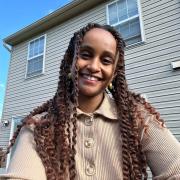
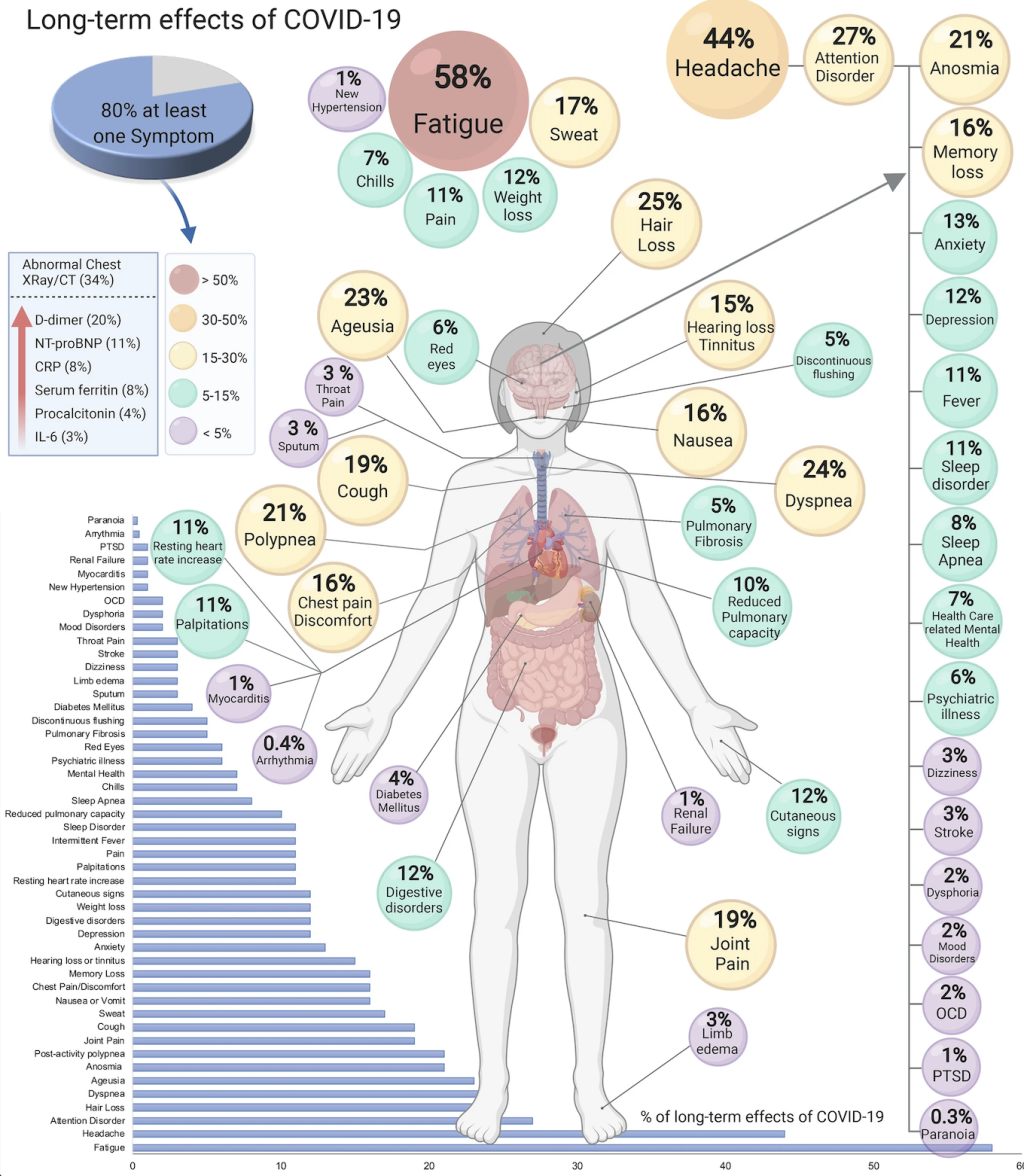
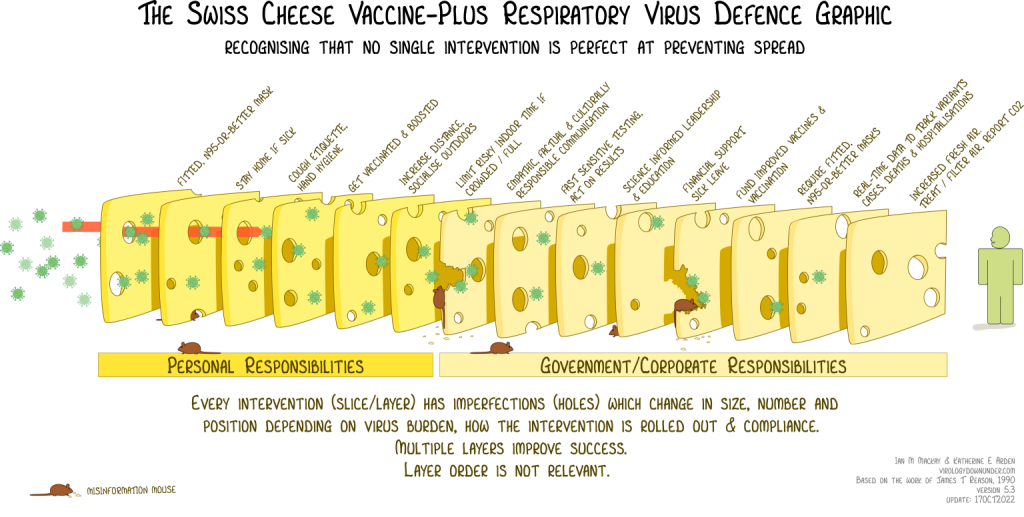
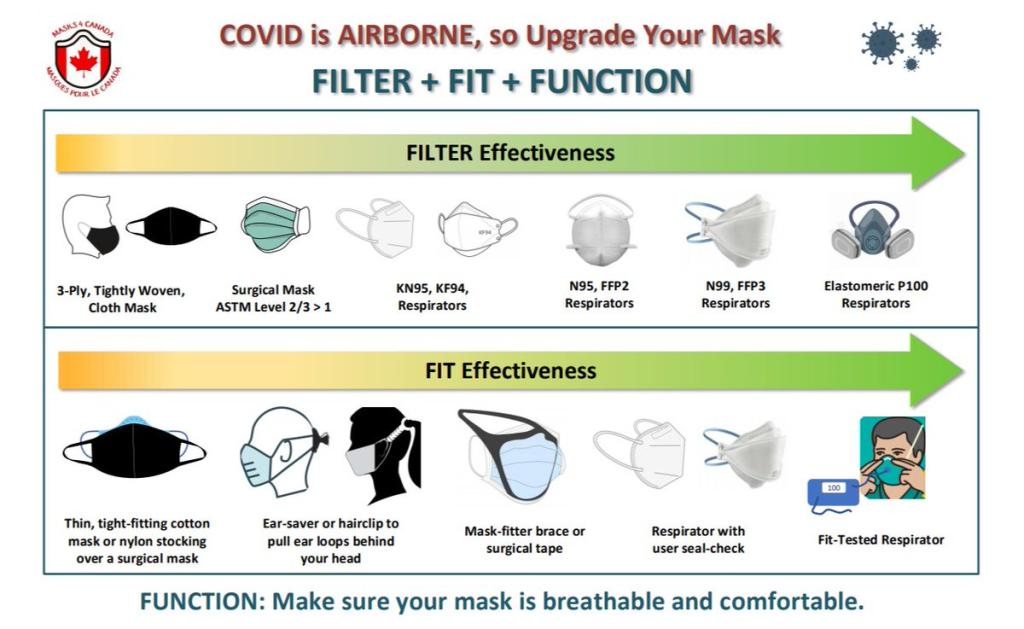
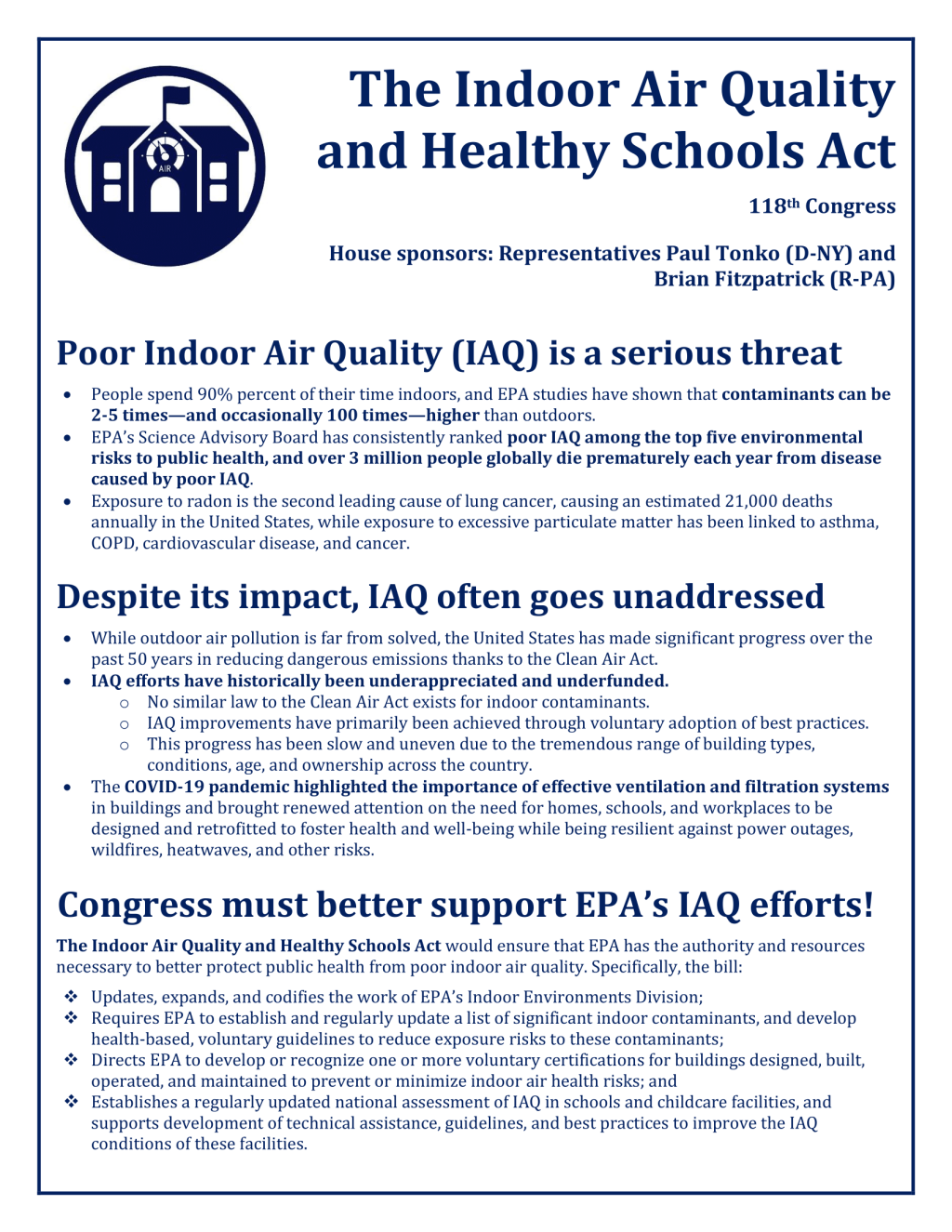
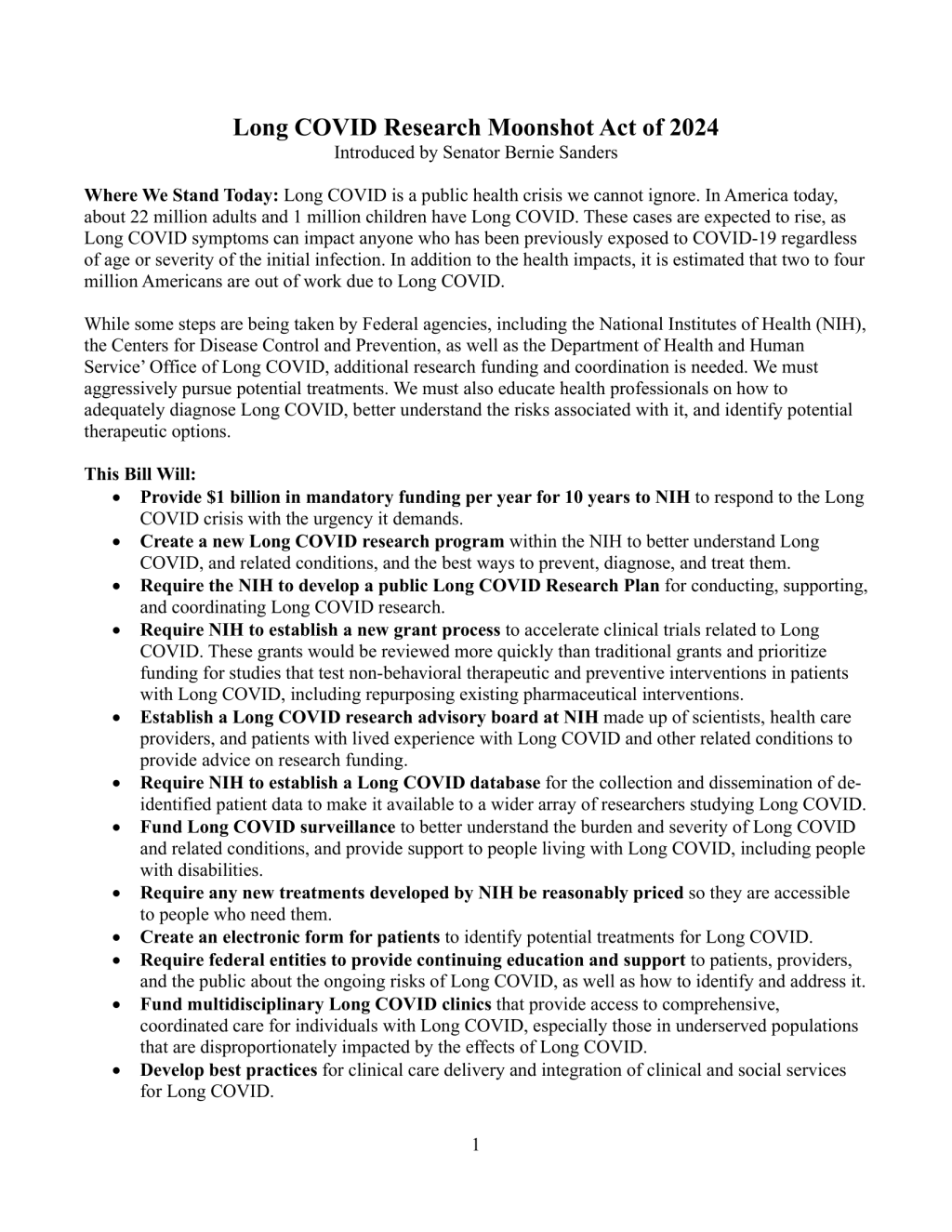


The views and opinions expressed in this post are those of the author(s) and do not necessarily reflect those of MomsRising.org.
MomsRising.org strongly encourages our readers to post comments in response to blog posts. We value diversity of opinions and perspectives. Our goals for this space are to be educational, thought-provoking, and respectful. So we actively moderate comments and we reserve the right to edit or remove comments that undermine these goals. Thanks!